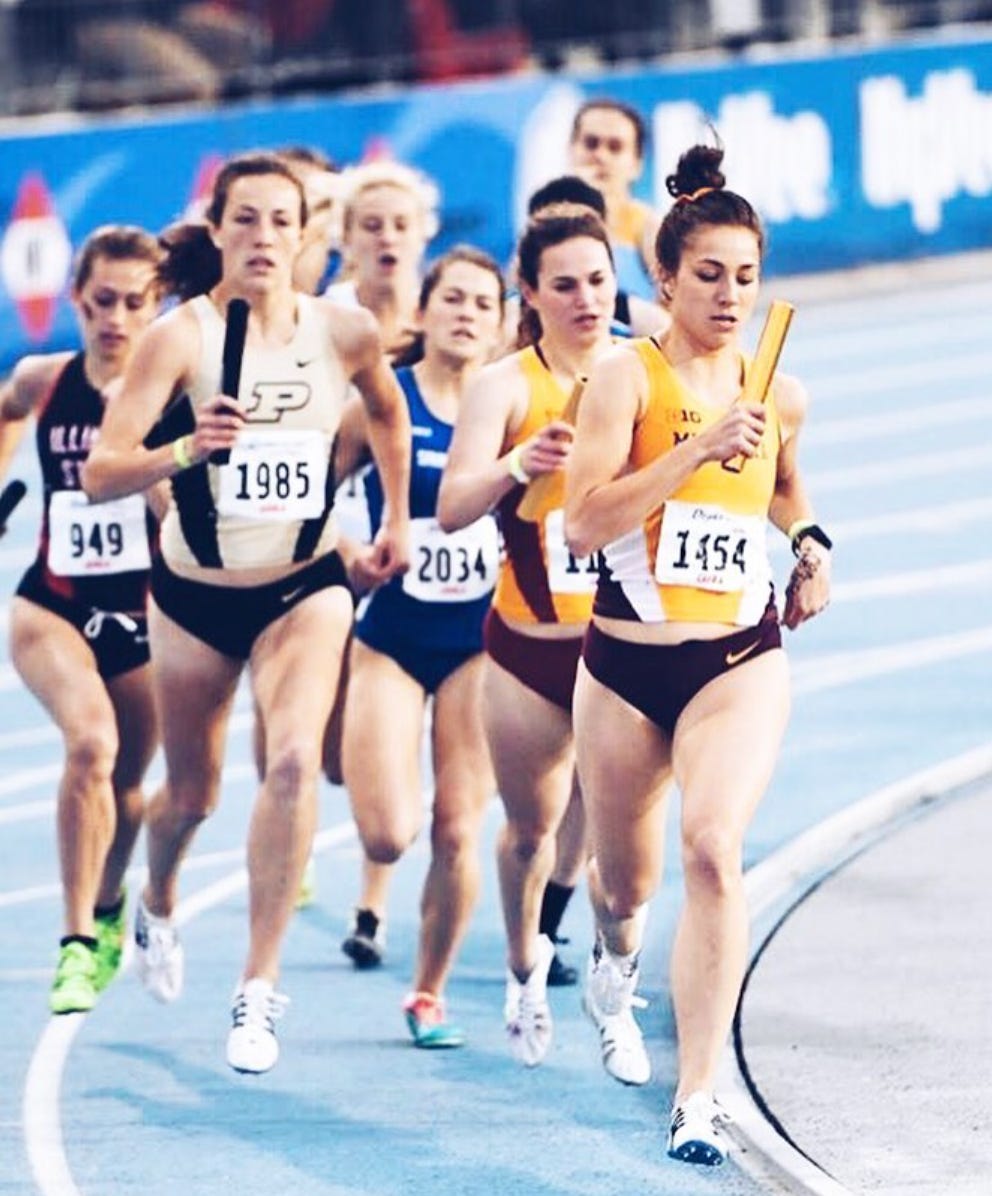my hot take on "fitness" trackers… 👀
the pros and cons of apple watches, oura rings, fitbits, & beyond.
Something you may or may not know about me— I was once a Division I collegiate track athlete. (For those of you runners who “talk the talk”, mid-distance was my specialty. Specifically, the 800m. I LOVED it.).
And while I did naturally gravitate towards the sport, I grew up in a tiny town of about 2,000 people. My school didn’t have a true track or facility.
So, most of our training was done on vacant dirt roads. Our training consisted of simple routes around town— dubbed “the 2.8 mile loop”, “the 4 mile route”, “the traintracks”, or even thee infamous “6-mile out and back” (which I ran one time, felt like I was going to perish, and swore it was the longest run I would EVER do.)
Despite these humble beginnings, I lucked out with a dedicated coaching staff who nurtured my interest in the sport. I ultimately found some success, managed to win a state title, & started to get college interest. I couldn’t believe it! I LOVED running. I LOVED racing. I LOVED my teammates. I genuinely wouldn’t change a thing about my experience running in high school— but I’ll be the first to admit it was definitely more of a humble, “small town” approach to training.
Flash forward to joining a Division I track program— and I was in a very different ballgame.
Suddenly even “normal” work outs were 6-10 miles (WHAT). I quickly learned that college-level training runs had much more strategy than just aimlessly running a generic 4-mile loop. I became familiar with terms like recovery, threshold, tempo, and even “fartleks”. I had a brand spankin’ new wardrobe of Nike running-specific gear (instead of the generic basketball shorts & cotton T-shirts that I previously wore).
…and I quickly noticed that everyone wore a watch while they ran.
my first experience “tracking” my health:
I know this sounds so naive (because, um, it WAS), but prior to college, I had truly *never* tracked a run in my life.
I didn’t know what my “mile pace” was. I didn’t know how far of a distance I typically went (unless of course, it was “thee 2.8 mile loop”). All I knew was leisurely jogging around my hometown & racing fast when it mattered.
…But *this* was different.
Suddenly, workouts were measured in minutes, paces, & miles.
Not intuition, town landmarks, or general distances.
(And, honestly, as they should’ve been! This was a Division I program after all. Performance mattered. Metrics mattered. Training mattered. None of this was “bad”. It was what it was.)
…it was simply new to *me*.
I remember feeling so dumb & inadequate at our training camp when I was the only one without a watch. Within my first week of joining the team, I asked my boyfriend to drive me to the off-campus Target so that I could get a Timex, and that was that.
I had a watch.
And I was hooked.
once you track, you don’t go back.
This was the era before GPS running watches (thank god), so I’m literally talking about a generic stopwatch.
Start & stop— that’s it.
But it felt (and objectively was) so IMPORTANT.
From the moment I hit the pavement, I hit the “green” button. I paused it at every stoplight. I stopped it when I was done. Our coaches told us to generally consider running for 8 minutes as 1 mile ran.
I started doing 16-minute warm ups (which my brain quickly began to correlate with 2 miles) and 12-minute cooldowns (1.5 miles). I did a 72-minute long run on the weekends (which became synonymous with 9 miles).
And suddenly I had a “metric” attached to every run— how many minutes it was. And subsequently how many miles that correlated to.
THEE timex stopwatch in action. Of course worn on the inside of my wrist— like all TRUE runners wore it. (If you know, you know.)
…. but what about STEPS?!
Then, around my junior year, technology progressed. A new gadget called Fitbits were all the rage.
Now, instead of how many minutes— I had a new fixation. Everyone was talking about STEPS.
And I wanted one so. badly.
On my college budget, I couldn’t afford the state-of-the-art device, but I asked my parents for the “Fitbit charge” for Christmas and I couldn’t wait to see how many steps I got on my run that day!!!!!! (…again, a metric that I had never once cared about before.)
Before you knew it— I wore my timex and my fitbit 24/7.
I made sure to wear it for every lift, walk to class, and run. I was devastated if it wasn’t charged and I had to “miss” the steps of a workout. (Even though my physical body *was* getting the steps— it obviously didn’t “count” unless my little device captured it.)
Between track training & walking around a large campus & 12-hour nursing clinical, my average step-count during that time of my life was 17,500-25,000 per day in college. And I was proud of it.

But what about pace?! And exact distance?! And sleep?! and heart rate?!
Then, my senior year, technology took a leap again. Garmin started releasing more-affordable, accessible GPS running watches. They had lime green, pink, & purple straps. One girl on my team got one. Then another. Then another.
Instead of just time & steps, it could also tell distance! Pace! Measure my cross-training! My sleep!
And I needed it.
I spent a few hundred dollars of my hard-earned money from my summer internship, and suddenly I was wearing a bulky mini computer on my wrist 24/7 to measure everything— from my runs to my lifts all the way to my walks to class & sleep quality & even heart rate. And I loved it.
I was shocked to see that some of my runs often weren’t actually the textbook “8-minute-pace” at all! Sometimes they were 7:27s (gosh, I’m fast!) sometimes they were 8:11’s (gasp! sloth-like!).
…And it opened up a whole new level of “tracking” my performance.

there’s a time & place.
Enter: an era of measuring every warm up, split, long run, & race. I knew my exact splits, distances, & pace.
And, honestly?
I don’t regret it.
At that point in my life, tracking my runs closely *was* important.
I think the important thing was that I used the data of the watch from a grounded place— I didn’t just care about running faster & faster & faster on every regular run. Moreso, I wanted my runs to serve their purpose. I wanted my easy runs to be easy. I wanted my hard runs to be hard. I ran slower on recovery days & I ran faster on training days.
After 4 years of collegiate running, things were really starting to “click”. And it definitely wasn’t because of the watch/data, but regardless it was all starting to come together. I set PRs in the 800! The 600! The 400! I got to run at Drake Relays! Our team won the Big 10 conference title my senior year! There is really only one season of my *entire* life where running fast will really matter to me— and that was it.
I’m proud to say that I gave it my all. I truly will treasure those races, my teammates, & traveling around the country to compete in my favorite sport for the rest of my life.
…But then I graduated & transitioned to being a “hobby jogger”, and my relationship with that pesky watch was flipped upside down.
WHY do I care so much?
Suddenly… I had no coach to report to. No training log to fill out. No pre-prescribed work out to fulfill.
But yet…
I still felt the need to wear that dang watch.
I still felt the need to measure every run, yoga class, & walk.
I still felt the need to hit a certain amount of steps per day.
I felt the need for my runs to still be near that 8-minute-mile benchmark.
And, ultimately, I still felt the need to QUANTIFY every. single. work. out.
Even though I was in an entirely different stage of life, and even though those metrics weren’t really relevant anymore.
I was still active. I was still moving my body every day. I was still healthy. I was still prioritizing my fitness.
So WHY did I care if I hit 9,728 steps instead of 10,000, ran 4.98 miles instead of a perfect 5.00, or had a 8:24 mile pace instead of the benchmark 8:00 pace?
Logically, I knew that it didn’t really make a difference. Logically, I knew that I was already committed to moving my body regularly. Logically, I knew that I didn’t really have anything I was training for.
…But, DANG, it was still harder than expected to break-free of that metric-based approach to wellbeing that I had become so accustomed to.
Which, bring me to today’s topic— fitness trackers. The good, the bad, & the in-between.
From apple watches to garmin, all the way to fitbit & oura ring, today I am going to talk about pros, cons, & my current approach to utilizing these devices.
The fitness tracking landscape has evolved rapidly in the last decade, offering countless ways to monitor our bodies on steps, calories, and every metric imaginable.
But is this actually a good thing? Here’s my hot take on fitness trackers…







